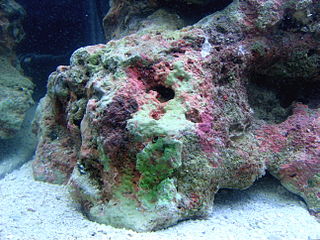
Live rock is rock from the ocean that has been introduced into a saltwater aquarium. Along with live sand, it confers to the closed marine system multiple benefits desired by the saltwater aquarium hobbyist. The name sometimes leads to misunderstandings, as the "live rock" itself is not actually alive, but rather is simply made from the aragonite skeletons of long dead corals, or other calcareous organisms, which in the ocean form the majority of coral reefs. When taken from the ocean it is usually encrusted with coralline algae and inhabited by a multitude of marine organisms. The many forms of micro and macroscopic marine life that live on and inside of the rock, which acts as an ideal habitat, give it the name "live rock".
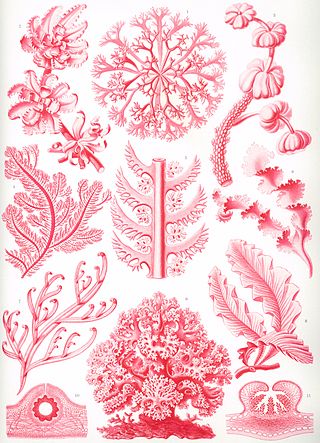
Florideophyceae is a class of exclusively multicellular red algae. They were once thought to be the only algae to bear pit connections, but these have since been found in the filamentous stage of the Bangiaceae. They were also thought only to exhibit apical growth, but there are genera known to grow by intercalary growth. Most, but not all, genera have three phases to the life cycle. In the subclass Nemaliophycidae there are three orders, Balbianiales, Batrachospermales, and Thoreales, which lives exclusively in freshwater.
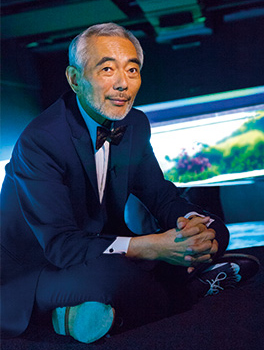
Takashi Amano was a professional track cyclist, photographer, designer, and aquarist. His interest in aquaria led him to create the Japanese company Aqua Design Amano.
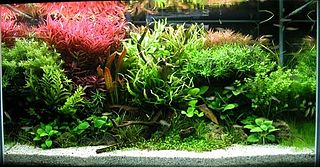
Aquascaping is the craft of arranging aquatic plants, as well as rocks, stones, cavework, or driftwood, in an aesthetically pleasing manner within an aquarium—in effect, gardening under water. Aquascape designs include a number of distinct styles, including the garden-like Dutch style and the Japanese-inspired nature style. Typically, an aquascape houses fish as well as plants, although it is possible to create an aquascape with plants only, or with rockwork or other hardscape and no plants.

Fishkeeping is a popular hobby, practiced by aquarists, concerned with keeping fish in a home aquarium or garden pond. There is also a piscicultural fishkeeping industry, serving as a branch of agriculture.

Taxiphyllum barbieri, known as Java moss or Bogor moss, is a moss belonging to the family Hypnaceae. Native to Southeast Asia, it is commonly used in freshwater aquariums. It attaches to rocks, roots, and driftwood. In the wild, it grows in humid riparian areas.

The Siamese algae-eater is a species of freshwater fish in the carp family, Cyprinidae. This bottom-dwelling tropical fish is found in mainland Southeast Asia, including the Chao Phraya and Mekong basins as well as the Malay Peninsula. Its natural habitats are streams and rivers as well as flooded forests during the rainy season. The Siamese algae-eater should not be confused with the flying fox or the false siamensis , lacking the distinctive black bands of the former.
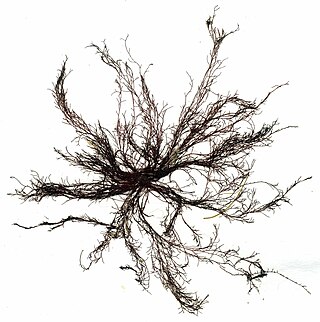
Polysiphonia, known as red hair algae, is a genus of filamentous red algae with about 19 species on the coasts of the British Isles and about 200 species worldwide, including Crete in Greece, Antarctica and Greenland. Its members are known by a number of common names. It is in the order Ceramiales and family Rhodomelaceae.

Vittina natalensis, commonly known as spotted nerite or zebra nerite, is a species of small freshwater snail with an operculum, an aquatic gastropod mollusk in the family Neritidae, the nerites. It returns to brackish waters to reproduce. This is a popular aquarium snail, sold because it looks attractive and eats algae in freshwater tanks, but can only reproduce in saltwater or brackish water conditions.
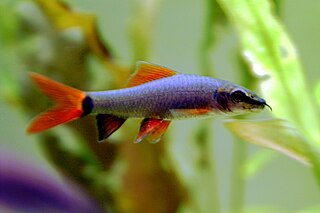
The rainbow shark is a species of Southeast Asian freshwater fish from the family Cyprinidae. It is also known as the ruby shark, red-fin shark, red-finned shark, rainbow sharkminnow, green fringelip labeo, whitefin shark and whitetail sharkminnow. It is a popular, semi-aggressive aquarium fish. Unlike true sharks, which belong to the Chondrichthyes lineage, the rainbow shark is an actinopterygiian.

The flying fox is a Southeast Asian species of freshwater fish in the family Cyprinidae. It is commonly kept in the aquarium trade. Among other foods, it is known to eat green algae. It is sometimes mistakenly referred to as the Siamese algae eater.

The Delesseriaceae is a family of about 100 genera of marine red alga.

Red algae, or Rhodophyta, make up one of the oldest groups of eukaryotic algae. The Rhodophyta comprises one of the largest phyla of algae, containing over 7,000 recognized species within over 900 genera amidst ongoing taxonomic revisions. The majority of species (6,793) are Florideophyceae, and mostly consist of multicellular, marine algae, including many notable seaweeds. Red algae are abundant in marine habitats. Approximately 5% of red algae species occur in freshwater environments, with greater concentrations in warmer areas. Except for two coastal cave dwelling species in the asexual class Cyanidiophyceae, no terrestrial species exist, which may be due to an evolutionary bottleneck in which the last common ancestor lost about 25% of its core genes and much of its evolutionary plasticity.

Kappaphycus is a genus of red algae. Species are distributed in the waters of East Africa, Indonesia, Malaysia, Hainan Island, the Philippines, and Micronesia.
Martensia bibarii is a species of red algae.

Crossocheilus langei, also known as the red algae eater, is a species of ray-finned fish in the genus Crossocheilus. It is native to Malaysia and Sumatra. This bottom-dwelling tropical fish is found in mainland Southeast Asia. Its natural habitats are streams and rivers as well as flooded forests during the rainy season. It is often confused with the Crossocheilus oblongus, however, both are algae eaters and will behave similarly.

Peyssonneliales is a monotypic order of red algae belonging to the class Florideophyceae and the subclass Rhodymeniophycidae. It contains only 1 known family, PeyssonneliaceaeDenizot, M., 1968.

There are many types of algae that are commonly found in a freshwater aquarium setting. They are typically considered a nuisance and subject to removal through the use of algicides, the release of algae eaters, and implementation of algae scrubbers. However, total elimination of algae is considered unlikely in a hobby aquarium. Algae can be used as an bioindicator to inform an aquarist on water chemistry and other conditions.
Caloglossa is a genus of algae in the Delesseriaceae.

















